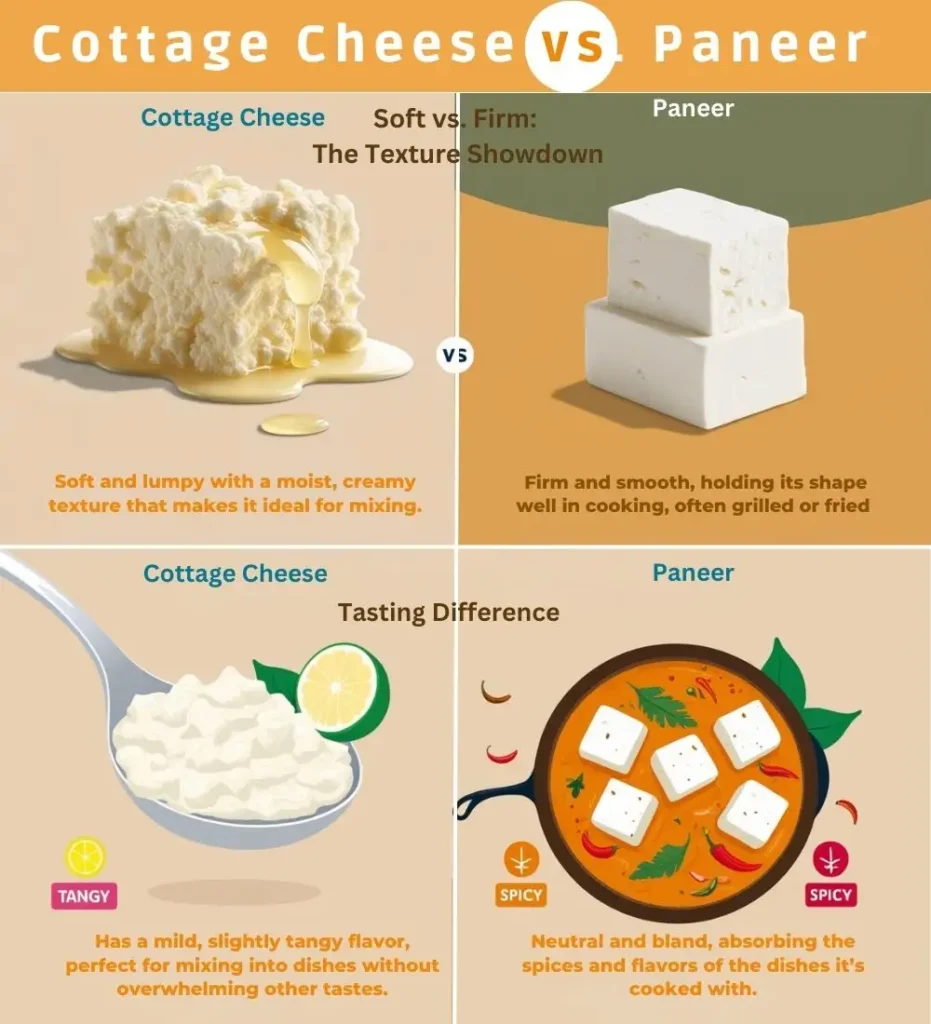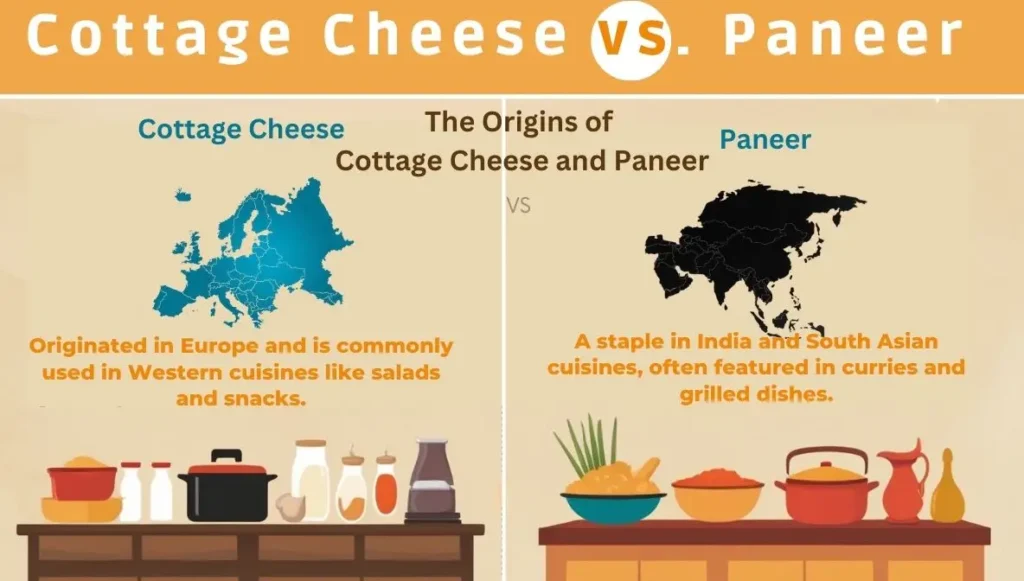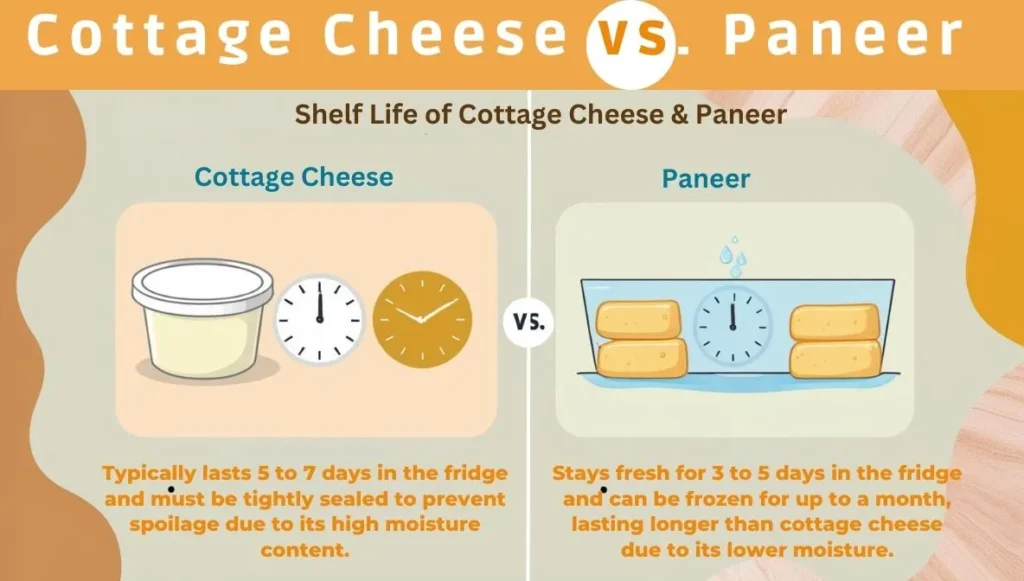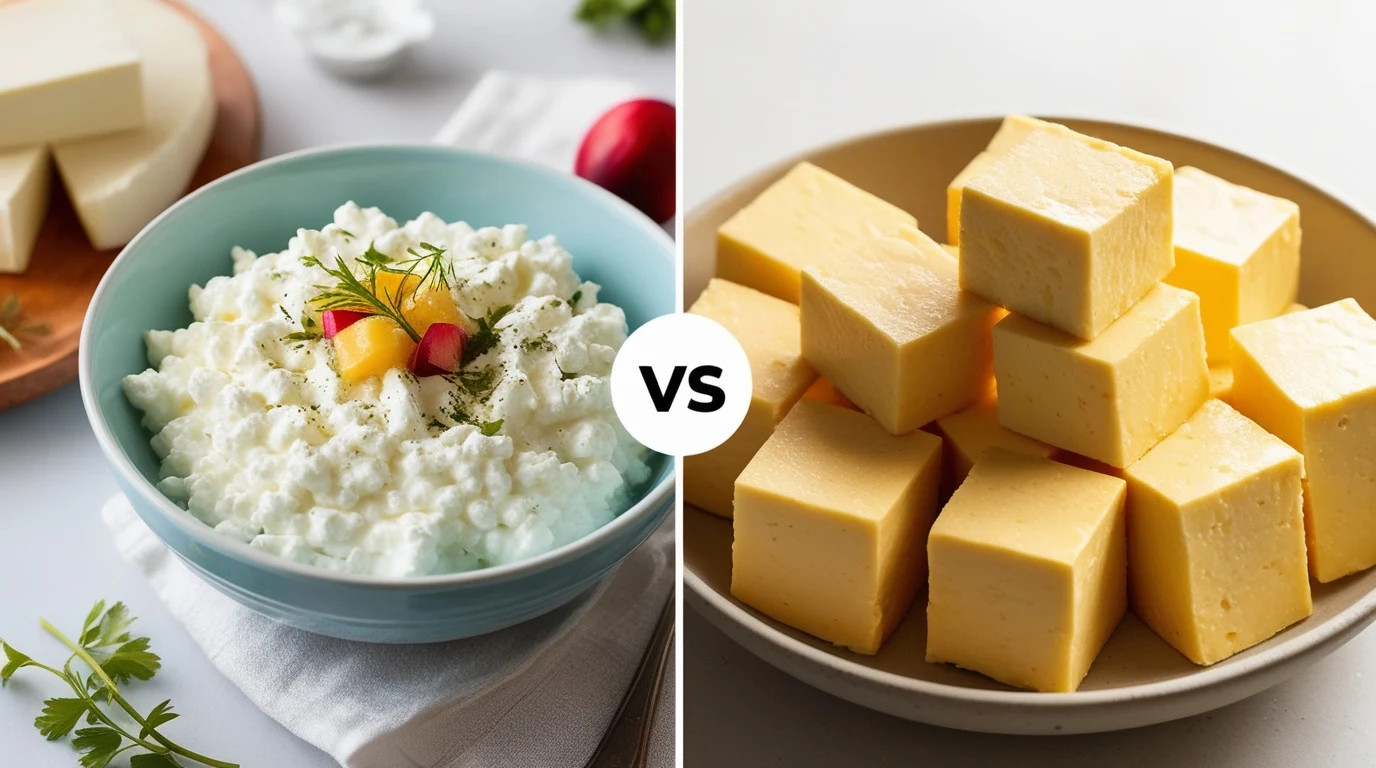Cottage cheese and paneer are fresh cheeses with distinct textures, preparation methods, and regional significance. Cottage cheese, creamy and tangy, is a Western favourite for salads and desserts, while paneer, firm and mild, is a staple in Indian cuisine, perfect for curries and grilled dishes.
Both are rich in protein and calcium, but their unique qualities make them suitable for different culinary uses.
Curious about the differences between cottage cheese vs paneer? This guide breaks down their textures, origins, nutritional benefits, and uses,

Also Read our Complete guide on: Discovering The Cottage Cheese: Origin, uses, Nutritional Benefits, production
What Are Cottage Cheese and Paneer?
Cottage cheese is a fresh, unripened cheese made from curdled milk. Its creamy, moist texture and slightly tangy flavour make it ideal for light meals and snacks. A common ingredient in Western diets, it pairs well with both savoury and sweet dishes.
Paneer, by contrast, is a soft cheese with a firm and dense texture. Originating in South Asia, paneer is made without the use of rennet, a coagulating enzyme, which makes it suitable for vegetarians. Its mild, neutral taste allows it to absorb flavours from spices and marinades, making it indispensable in Indian cooking.
Both are rich in protein and calcium, making them ideal for muscle repair and bone health. However, their preparation methods, flavour profiles, and cultural contexts set them apart.
Origins and History

Cottage Cheese: A Western Delight
The history of cottage cheese dates back to ancient Mesopotamia, where people curdled milk to create fresh cheeses.
In modern times, cottage cheese became popular in Europe and the United States as a low-fat, high-protein food. Its name comes from its humble beginnings in cottages, where it was made from leftover milk.
Paneer: The Pride of India
Paneer has a long history in Indian cuisine, which has been mentioned in ancient texts like the Rigveda. Over centuries, it became a staple in South Asian diets, particularly for vegetarians.
Unlike Western cheeses, paneer is acid-set (made using lemon juice or vinegar) and doesn’t require ageing.
Also Read: Camembert Cheese: A Comprehensive Guide
For a deeper dive into Cottage Cheese’s history and uses, visit Cottage Cheese on Wikipedia.
How Are Cottage Cheese and Paneer Made?
The Cottage Cheese Process
- Milk Preparation: Milk is heated gently to a specific temperature.
- Curdling: An acidic agent such as vinegar, lemon juice, or lactic acid bacteria is added to separate curds from whey.
- Draining: The curds are drained but not pressed, retaining a high moisture content.
- Cream Addition: Cream is mixed into the curds for extra richness, creating a soft and creamy texture.
This process results in a cheese with a crumbly consistency and tangy taste.
The Paneer Process
- Milk Heating: Full-fat milk is boiled to a high temperature.
- Curdling Agent: Lemon juice, vinegar, or yogurt is added to coagulate the milk.
- Draining and Pressing: The curds are separated and pressed under weight to remove excess whey.
- Shaping: The pressed curds form a firm block that can be sliced or cubed.
Unlike cottage cheese, paneer is pressed to create its dense texture, making it ideal for cooking in a variety of ways.
Nutritional Comparison: Cottage Cheese vs Paneer
| Nutrient | Cottage Cheese (100g) | Paneer (100g) |
|---|---|---|
| Calories | 98 | 265 |
| Protein | 11g | 18g |
| Fat | 4.3g | 20g |
| Carbohydrates | 3.4g | 2.6g |
| Calcium | 83mg | 208mg |
Which Is Healthier?
- Cottage Cheese: Lower in calories and fat, making it a go-to choice for weight loss or low-fat diets.
- Paneer: Higher in fat, ideal for energy-dense diets like keto. Its high protein content makes it perfect for muscle building.
Both are excellent sources of calcium, supporting bone health. However, paneer’s higher calorie content might not suit calorie-restricted diets.
Also Read: Cream Cheese Essentials: Everything You Need to Know
Culinary Differences: How They Are Used
Cottage Cheese: Creamy and Tangy
Cottage cheese’s creamy texture makes it versatile:
- Breakfasts: Spread on toast or mixed into oatmeal.
- Salads: Added to greens for a protein boost.
- Desserts: Used in cheesecakes or blended into smoothies.
Paneer: Firm and Mild
Paneer’s firm texture and neutral taste make it ideal for:
- Curries: Staples like palak paneer and paneer butter masala.
- Grilled Dishes: Cubes marinated and grilled as paneer tikka.
- Snacks: Fried paneer pakoras or stuffed parathas.
Can They Be Substituted?
Yes, but with limitations. Cottage cheese can replace paneer in salads or dips but not in curries where firmness is essential. Paneer may not work in recipes requiring a creamy texture.
Taste and Texture: A Closer Look
Cottage Cheese
- Taste: Cottage cheese has a distinct tangy flavor, often accompanied by a slight saltiness. The tanginess comes from the fermentation process, which gives it a fresh, mildly sour taste that makes it a versatile ingredient in both savory and sweet dishes.
- Texture: Cottage cheese has a soft, crumbly texture that can range from slightly lumpy to smooth, depending on how finely the curds are broken down during the process. It’s typically moist and creamy due to the retained whey content.
- Moisture Content: The high moisture content in cottage cheese contributes to its creamy and delicate texture, making it light and refreshing. This is why it is often considered a “wet” cheese, ideal for mixing into salads, soups, or spreading on toast.
- Consistency: Cottage cheese’s consistency varies from low-fat options, which can be more liquid-like, to full-fat varieties, which are thicker and creamier. The variation in fat content affects the richness and mouthfeel of the cheese.
- Versatility: The tangy and creamy flavor of cottage cheese allows it to pair well with both sweet and savory foods. It can be used as a topping for fruit, a base for dips, or even incorporated into baked goods like cheesecakes.
- Serving: Cottage cheese can be served cold as a refreshing snack or breakfast item, or it can be used in cooked dishes, though its texture makes it less suited to heat-heavy recipes like curries.
Paneer
- Taste: Paneer has a mild, milky flavor that is relatively neutral, which makes it an excellent base for absorbing the spices and flavors it is cooked with. This makes paneer particularly versatile in dishes with rich, flavorful sauces, such as curries and stews.
- Texture: Paneer has a firm, compact texture due to the pressing process, which helps it hold its shape even when cooked. This is one of the key characteristics that differentiates it from other cheeses, as it doesn’t melt easily when heated.
- Firmness: The density and firmness of paneer make it ideal for grilling, frying, or cubing into chunks for curries. Its firm texture provides a satisfying bite and allows it to maintain its integrity during cooking.
- Absorption of Spices: Due to its relatively neutral taste and firm texture, paneer readily absorbs the spices and flavors of marinades or cooking liquids. This allows it to take on the taste of the dish it’s cooked in, making it adaptable to a wide range of flavors.
- Consistency: While soft and delicate when freshly made, paneer becomes firmer and more compact as it cools and is pressed. This firmness makes it versatile, able to withstand intense cooking methods such as frying and grilling without losing shape.
- Serving: Paneer can be served in various ways – sautéed, grilled, fried, or added to curries. Its texture allows it to be sliced, cubed, or crumbled, making it a popular choice for a variety of dishes, including paneer tikka, palak paneer, and paneer butter masala.
Shelf Life and Storage

Cottage Cheese
- Shelf Life: Short (1–2 weeks refrigerated).
- Storage Tips: Keep it sealed and consume quickly once opened. It’s prone to spoilage due to its high moisture content.
Paneer
- Shelf Life: Longer (2–3 weeks refrigerated).
- Storage Tips: Store in water to maintain moisture. Paneer can also be frozen for extended use.
Recomended Reading : The Ultimate Guide to Bel Paese Cheese: Origins, Characteristics, Uses
Health Benefits of Cottage Cheese and Panee
- Protein: Paneer offers more protein per serving compared to cottage cheese.
- Calcium: Paneer has a significantly higher calcium content, supporting bone health more effectively.
- Lactose: Paneer is more suitable for people with lactose intolerance.
- Weight Management: Cottage cheese is better for low-calorie diets, while paneer is ideal for energy-dense, high-fat diets like keto.
- Weight Loss vs. Muscle Gain: Cottage cheese is preferable for weight loss, while paneer is better for muscle building and high-energy needs
- Digestion: Cottage cheese is easier to digest due to its lower fat content, while paneer may be heavier for some individuals.
Looking for detailed nutrition information? Check out Cottage Cheese Nutrition on Healthline.
Cultural and Global Popularity
Cottage Cheese
In Western diets, cottage cheese is synonymous with healthy eating. It’s often paired with fruits, nuts, or honey for breakfast and is a popular ingredient in weight-loss diets.
Paneer
Paneer dominates Indian cuisine and is gaining global recognition. Vegetarian-friendly and adaptable, it’s now a staple in fusion dishes like paneer tacos and wraps.
FAQs About Cottage Cheese and Paneer
Is Cottage Cheese the Same as Paneer?
No, cottage cheese and paneer are different in texture, taste, and how they’re used in cooking. Cottage cheese is creamy and tangy, while paneer is firm and mild, making them suitable for different types of dishes.
Can You Use Cottage Cheese in Indian Recipes?
Cottage cheese can be used in some Indian recipes like dips or salads, but it doesn’t have the firm texture needed for curries. Paneer, on the other hand, holds its shape and is better suited for traditional Indian dishes.
Which Is Better for Weight Loss?
Cottage cheese is lower in calories and fat, making it a great choice for weight loss or low-fat diets. Its high protein content helps with muscle repair without adding excess calories or fat.
Recipes to Try
Cottage Cheese Smoothie Bowl
- Blend cottage cheese with berries, bananas, and honey.
- Top with granola and nuts for a nutritious breakfast.
Paneer Butter Masala
- Cook paneer cubes in a rich tomato-based gravy with Indian spices.
- Serve with naan or rice for a hearty meal.
Conclusion
Both cottage cheese and paneer are versatile, nutritious cheeses with unique characteristics. Cottage cheese is creamy and tangy, perfect for light, fresh dishes, while paneer is firm and mild, making it the star of savoury Indian recipes. By understanding their differences, you can choose the best option for your dietary and culinary needs.
More on Cheese
- Exploring Parmesan or Parmigiano-Reggiano cheese
- Mozzarella cheese | Origins, Production, uses
- The Ultimate Guide to Ricotta Cheese
- Homemade Ricotta Cheese Recipe
- Complete guide to Feta cheese
- The Ultimate Guide to Danish Blue Cheese
- 27 different types of cheese: their origin and uses
- Service of cheese in restaurants
Subscribe and join our community of hospitality professionals & students — get insights, tips, and the latest updates delivered straight to your inbox!







